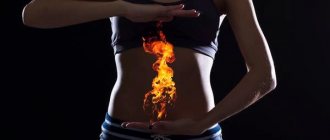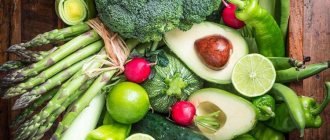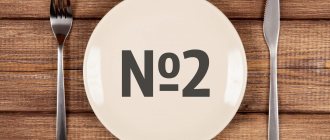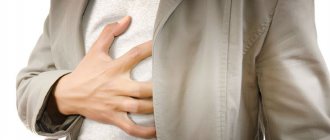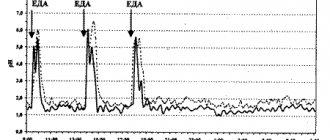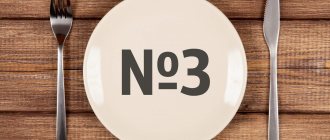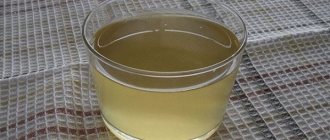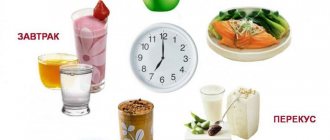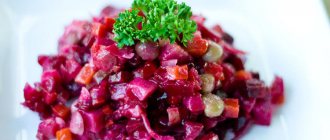Increased acidity is a process in which part of the gastric juice, whose specific gravity is more than half one percent, descends into the esophagus, where it irritates the esophageal mucosa. People with high acidity are characterized by symptoms such as a burning sensation in the chest, a feeling of acidity in the mouth (regardless of food intake).
- Briefly about the diet
- Diet principles
- Menu for high acidity
- Foods that increase acidity
- Menu for high acidity
- Diet recipes for high acidity
Most of us feel the same way from time to time. The reason lies in poor nutrition. For example, you ate food on the go, the food was too dry, or you preferred semi-finished and unnatural products. If uncomfortable sensations recur, or if this happens to you all the time, this indicates digestive problems. In this case, you can try a diet (nutrition) for high acidity. But, of course, the best option is to visit a therapist or gastroenterologist, especially when it comes to children's health.
Briefly about the diet
The cause of digestive problems sometimes remains a mystery to us. We don’t even suspect about them until obvious symptoms appear that change the quality of our life. Risk factors for high acidity:
- rare or irregular meals
- snacking on inappropriate foods
- excessive eating (large portions)
- food on the go
- fast food (McDonald's, etc.)
- semi-finished products
Strong, rich broths (even mushroom broths) are contraindicated in the diet for people with high acidity. Although some would-be experts recommend “hot stuff.” If the condition has worsened (symptoms have worsened), replace pickles and borscht with cream soups and soups with a mucous structure, for the preparation of which you take cereals such as rice or oatmeal.
For cooking, choose vegetables with minimal fiber content:
- carrot
- potato
- pumpkin
The following vegetables are not recommended:
- sorrel
- radish
- white cabbage
- radish
- ginger
Fruits with high acidity are acceptable, but they should be more sweet than sour. If symptoms worsen, you should not eat raw fruits; they are baked or boiled; there are even recipes on the Internet for fruit soups that are suitable for people with high acidity. You can puree the fruit or make a soufflé out of it.
It is possible to include meat in a diet with high acidity, but not fatty varieties. Meat can be prepared in the following ways:
- steaming (or in a double boiler)
- extinguishing
- boiling
In no case should you eat fatty meat if you have problems with acidity (for example, fatty parts of pork and rabbit). You cannot use a method of processing meat such as frying. Fatty foods are harmful because such food remains in the gastrointestinal tract for a long time, which can worsen the condition of a person with high acidity. We also get fat from oil (sunflower and butter), mayonnaise, various nuts, cream, peanut butter, potato chips, etc.
Harm and risks
Nutritionists consider a balanced diet and moderate physical activity to be the most preferable way to lose weight. A set of such actions has a better effect on the body, helping to lose weight, than a one-sided diet.
So, before you go to the supermarket with a list of products with an alkaline environment and start preparing food according to new principles, you should consult your doctor. There are certain contraindications that should be identified in each specific case. An alkalizing diet should be practiced with caution by those who suffer from the following conditions:
- liver failure;
- pathologies of the cardiovascular system;
- gastrointestinal problems.
This is not to mention the fact that indulging in a menu with a pronounced predominance of components of one type will not entail positive changes in the body.
In the stomach, when functioning properly, as a rule, only an acidic environment is observed. If you shift the acidity level in any direction, you can easily develop indigestion. In the presence of pathologically high acidity, a gastroenterologist copes well with the problem. In this case, no intervention or consumption of special dishes is required. It is recommended to follow your doctor's instructions and also seek help from qualified nutritionists to adjust the proportion of alkaline foods in your habitual shopping list.
Diet principles
Among the principles of the diet are the use of cereals and cereal side dishes. They can be cooked with milk and water. If the symptoms have worsened, during this period it is better to eat porridge with a thinner consistency; they are easier to digest. Doctors recommend fermented milk products and fresh milk for high acidity, for example cottage cheese. You can eat eggs.
As for drinks, the following are acceptable:
- drinking water (filtered or purchased)
- jelly
- compotes
- tea (not very strong)
- still mineral alkaline water
It is important to eat small portions and often, this is called fractional meals. Eating every two or three hours is acceptable. Food should not be washed down (this also applies to tea with desserts after the main meal). You can drink a glass of liquid 30 minutes before meals, or drink it 1-2 hours after meals.
List of components with the highest pH values
There is not always a direct connection between the acid balance of a dish and its effect on the body. For example, significant alkalization occurs when consuming lemon. And prunes, rich in minerals and vitamins, cause an acid-forming effect. Protein and flour foods promote the formation of acid, which is necessary to process food. The opposite reaction occurs when consuming raw vegetables, fruits, root vegetables, herbs, some dairy products and vegetable oils.
If you can’t identify a pattern, it doesn’t matter, check out the list of alkaline food products in the form of a convenient table to avoid mistakes when creating a menu:
All vegetables presented in the table are alkaline, but after heat treatment they lead to slight acidification of the body. The same thing happens to fruits after adding sugar.
Comment from the clinic's nutritionist
The optimal ratio of acidic to alkaline substances is 1:3. You should not completely give up foods that cause an acid-forming effect. It is important to maintain balance, because excess alkali can also cause harm.
Menu for high acidity
A diet with high acidity allows the consumption of baked goods:
- bread dried in a microwave or toaster (preferably not white)
- crackers
- cracker or biscuit cookies
- pasta and vermicelli (without sauces)
You can eat fresh or frozen cooked vegetables. They are steamed, mashed, boiled or stewed. Frying is prohibited.
What products can
Acceptable fruits:
- pear
- bananas
- avocado (be careful with the quantity, avocado contains a large amount of fat)
- peeled apple
Cereals with high acidity:
- oatmeal
- rice
- barley grits
- buckwheat
- semolina
- couscous
Sea fish is acceptable (it is better to avoid eating river fish); it is steamed, boiled, or baked in foil. You can have 3 to 4 eggs per week if you have high acidity. They are boiled or steamed into an omelet.
Preferably this meat:
- turkey
- chicken fillet
- veal
- rabbit meat (lean)
Desserts with high acidity:
- fruit mousses
- jelly
- marmalade
- souffle
- paste
- marshmallows
- honey
- preserves and jams (non-sour)
- cracker
Signs of excess acid (acidosis)
It is recommended to think about which foods in your diet are alkaline and wisely adjust their share in the diet if conditions indicating acidification are noted. These signs include:
- difficulties in the gastrointestinal tract;
- dryness, flaking of the skin, tendency to form early wrinkles; m
- clogged pores, inflammation, acne;
- brittle nails, dullness and hair loss;
- little energy - fatigue sets in quickly, going to the store or going to the gym requires significant volitional effort;
- painful sensations in muscles and joints;
- vulnerability to viral respiratory infections;
- frequent migraines, dizziness from minor physical exertion;
- neoplasms;
- problems in the functioning of the cardiovascular system.
You can also obtain information about the body's ACHB using litmus paper in urine or saliva. If after contact with the liquid the litmus turns green, then your health is normal. Yellow indicates that there is a high risk of developing pathologies and susceptibility to infectious diseases. If the indicator is orange or red, this means the need for urgent and radical changes and close attention to yourself. Such shades indicate the pronounced acidity of saliva.
Our additional services: Bioimpedance | Marutaka Massage | Pressotherapy | Ion-Detox
Foods that increase acidity
If you have high stomach acidity, it is better to avoid foods and dishes that will increase it even more. This includes the following bakery products:
- buns
- fresh baked goods made from premium wheat flour
- pies (especially fried ones)
- puff pastry and all products made from it
- pizza
- chebureks and khachapuri
- pastries and cakes
The following foods irritate the gastric mucosa:
- corn
- nuts and seeds
- snacks and chips
- crackers with salt
- convenience foods and fast food
- smoked meats (smoked cheese, for example)
- fast food
Prohibited for high acidity:
- salo
- red meat
- animal by-products (eg kidneys)
- sausages and sausages
- sour fruits
- juices based on sour fruits
- oil creams
- chocolate
- desserts containing nuts that are coated with glaze
- sweets with preservatives and synthetic colors
- ice cream
It is undesirable to consume such products if you have high stomach acidity:
- sauces
- herbs and spices
- broths and gravies
- marinades
- adjika
- mayonnaise and ketchup
- alcoholic drinks (you also need to stop smoking)
- energy
- any carbonated drinks
- cocoa and coffee
- hot chocolate
- pickles
The diet must be strictly adhered to while symptoms worsen. Small retreats are possible when a person feels lighter.
Alcoholic drinks
Alcohol is one of the main enemies of a normal acid-base environment. Even small doses cause a serious release of a substance that corrodes the walls of the stomach. Doctors say that the following drinks are more harmful than others:
- wine;
- alcohol tinctures;
- champagne;
- unfiltered beer.
Regular consumption of alcohol inevitably leads to problems with the gastrointestinal tract, which are not easy to solve. For people already suffering from gastritis, ulcers, or pancreatitis, alcohol is strictly contraindicated. Healthy people should reduce their alcohol consumption to a minimum, or better yet, abstain from it altogether.
Menu for high acidity
First day
For tomorrow, make steamed cheesecakes with sour cream. Drink: tea with milk. Yoghurt is suitable as a snack, preferably homemade. For lunch, oatmeal soup, steamed meatballs, carrot puree and non-sour compote are suitable. As an afternoon snack - tea with biscuits. The best dinner option: steamed fish, pasta and jelly.
Second day
Breakfast includes oatmeal with honey and herbal tea. As a snack, you can give the patient milk with a cracker (it is better to make crackers at home to avoid strange impurities). Lunch menu: creamy zucchini soup, vegetable stew, green tea. For an afternoon snack, you can eat a banana or half an avocado. For dinner, dumplings are served with potatoes (minimal oil) and compote.
The third day
For breakfast, boil an egg (or several), give dried bread with cheese; drink: compote. You can bake an apple for a snack. For lunch they give milk soup, steamed chicken and tea. An excellent option for an afternoon snack would be a glass of kefir and a couple of biscuits. For dinner you can have rice casserole, boiled or stewed vegetables and jelly.
Fourth day
An excellent breakfast option is a steamed omelette and tea with milk. For a snack, you can give the patient jelly with cookies (the composition should contain a minimum of fat and fiber). For lunch, they serve rice-based soup, boiled veal, vegetables (boiled or steamed) and non-acidic compote. For an afternoon snack you can have a pear. For dinner, boiled potatoes with vegetables and rosehip tea are suitable.
Fifth day
Prepare cottage cheese casserole for breakfast in a double boiler or oven. Herbal tea is also served. A glass of milk and cookies or a sweet cracker will do as a snack. For lunch they provide barley soup, chicken meatballs with a side dish of rice, and carrot juice. For an afternoon snack, bake a sour apple. For dinner they serve pasta with cottage cheese; drink: jelly.
Sixth day
For breakfast, you can give the patient cottage cheese with sour cream and compote. After some time, you can have a snack with tea with soufflé or marshmallows. For lunch, onion soup and steamed fish ball are suitable. Drink for lunch: tea. Apple jelly is served for afternoon tea. Possible dinner: potato casserole with sour cream, jelly.
Seventh day
For breakfast, if you have high acidity, you can have semolina pudding with jam and tea with cream (minimum fat content, 10% possible). As a snack, you can give cookies and yogurt or sourdough. Sample lunch: creamy cauliflower soup, sea fish cooked in foil with herbs, compote. An afternoon snack could be something like this: cottage cheese with jam. For dinner on the seventh day, you can serve rice cutlets with a vegetable side dish and jelly.
Half an hour before bedtime, you can drink 150-200 ml of milk, kefir or yogurt. Based on the acceptable products listed above, you can prepare all new dishes. Nutrition can and should be varied.
Description
The stomach always produces hydrochloric acid. If this organ functions normally, then it does not destroy its mucosa, the walls of the esophagus and the duodenum. Hydrochloric acid helps neutralize pathogenic microorganisms, so it is necessary for the normal functioning of the digestive tract.
But disruption of the processes of secretion and neutralization of hydrochloric acid leads to an increase in its content in gastric juice. An excess of this substance causes:
- stomach burn;
- pathological activity of Helicobacter;
- intoxication with chemicals;
- pathological disorders of pancreatic functioning;
- liver diseases.
- The most severe complications of this condition are oncological pathologies and the development of a perforated ulcer.
Features of treatment [edit | edit code ]
Highly concentrated hydrochloric acid is a caustic substance
, upon contact with skin causes severe chemical burns. Contact with eyes is especially dangerous. To neutralize burns, use a solution of a weak base, or a salt of a weak acid, usually baking soda.
When opening vessels with concentrated hydrochloric acid, hydrogen chloride vapors, attracting air moisture, form a fog that irritates the eyes and respiratory tract of humans.
In the Russian Federation, the circulation of hydrochloric acid with a concentration of 15% or more is limited [6].
«>2>
Chemical properties [edit | edit code ]
- Interaction with metals in the series of electrochemical potentials up to hydrogen, with the formation of salt and the release of hydrogen gas:
2 N a + 2 HC l ⟶ 2 N a C l + H 2 ↑ <2Na+2 HCllongrightarrow 2 NaCl+ H_<2>uparrow >>>M g + 2 HC l ⟶ M g C l 2 + H 2 ↑ <2 >uparrow >>>2 A l + 6 HC l ⟶ 2 A l C l 3 + 3 H 2 ↑ <2Al+6 HCllongrightarrow 2 AlCl_<3>+3 H_<2>uparrow >>>
- Interaction with metal oxides to form soluble salt and water:
N a 2 O + 2 HC l ⟶ 2 N a C l + H 2 O O+2 HCllongrightarrow 2 NaCl+ H_<2>O>>>M g O + 2 HC l ⟶ M g C l 2 + H 2 O + H_<2>O>>>A l 2 O 3 + 6 HC l ⟶ 2 A l C l 3 + 3 H 2 O O_<3>+6 HCllongrightarrow 2 AlCl_<3>+3 H_<2>O>> >
- Interaction with metal hydroxides to form soluble salt and water (neutralization reaction)
:
N a OH + HC l ⟶ N a C l + H 2 OO>>>B a ( OH ) 2 + 2 HC l ⟶ B a C l 2 + 2 H 2 O +2 HCllongrightarrow BaCl_<2>+2 H_< 2>O>>>A l ( OH ) 3 + 3 HC l ⟶ A l C l 3 + 3 H 2 O <3>+3 H_<2>O>>>
- Interaction with metal salts formed by weaker acids, such as carbonic acid:
N a 2 CO 3 + 2 HC l ⟶ 2 N a C l + H 2 O + CO 2 ↑ 2> CO_<3>+2 HCllongrightarrow 2 NaCl+ H_<2>O+ CO_<2>uparrow >>>
- Interaction with strong oxidizing agents (potassium permanganate, manganese dioxide) with the release of chlorine gas:
2 KM n O 4 + 16 HC l ⟶ 5 C l 2 ↑ + 2 M n C l 2 + 2 KC l + 8 H 2 O <2KMnO_<4>+16 HCllongrightarrow 5 Cl_<2>uparrow +2 MnCl_<2 >+2 KCl+8 H_<2>O>>>
- A qualitative reaction to hydrochloric acid and its salts is its interaction with silver nitrate, which produces a white cheesy precipitate of silver chloride, insoluble in nitric acid [4]:
HC l + A g NO 3 → A g C l ↓ + HNO 3 3> ightarrow AgCl+HNO_3>>>>
Receiving [edit | edit code ]
Hydrochloric acid is prepared by dissolving hydrogen chloride gas in water. Hydrogen chloride is produced by burning hydrogen in chlorine; the acid obtained in this way is called synthetic. Hydrochloric acid is also obtained from exhaust gases - by-product gases formed during various processes, for example, during the chlorination of hydrocarbons. The hydrogen chloride contained in these gases is called free gas, and the acid thus obtained is called free gas. In recent decades, the share of gas-free hydrochloric acid in production volume has gradually increased, displacing acid produced by burning hydrogen in chlorine. But hydrochloric acid obtained by burning hydrogen in chlorine contains fewer impurities and is used when high purity is required.
In laboratory conditions, a method developed by alchemists is used, which consists of the action of concentrated sulfuric acid on table salt:
N a C l + H 2 SO 4 → 150 o CN a HSO 4 + HC l
3>2>SO_]C>>NaHSO_4>+HCl>>>
At temperatures above 550 °C and excess table salt, interaction is possible:
2 N a C l + H 2 SO 4 → 550 o CN a 2 SO 4 + 2 HC l
4>2>SO_]C>>Na_4>2>SO_+2HCl>>>
It is possible to obtain by hydrolysis of magnesium and aluminum chlorides (hydrated salt is heated):
M g C l 2 ⋅ 6 H 2 O → t, o CM g O + 2 HC l + 5 H 2 O
4>2>cdot 6H_2>O]C>>MgO+2HCl+5H_2>O>>> A l C l 3 ⋅ 6 H 2 O → t, o CA l ( OH ) 3 + 3 HC l + 3 H 2 O cdot 6H_3>2>O]C>>Al(OH)_+3HCl+3H_3>2>O>>>
These reactions may not proceed to completion with the formation of basic chlorides (oxychlorides) of variable composition, for example:
M g C l 2 + H 2 O → M g 2 OC l 2 + HC l
2>+H_2>O]>Mg_2>OCl_2>+HCl>>> [5]
Hydrogen chloride is highly soluble in water. Thus, at 0 °C, 1 volume of water can absorb 507 volumes of HCl, which corresponds to an acid concentration of 45%. However, at room temperature the solubility of HCl is lower, so in practice 36% hydrochloric acid is usually used.
Acid-base balance according to Neumyvakin
Professor I.P. Neumyvakin advised maintaining the balance of acids and alkalis as follows:
- Eat minimal amounts of all acidic foods, including meat. They acidify liquid environments, provoke uncontrolled production of free radicals, and wash calcium out of bone tissue.
- Increase the volume of clean water (1.5-2 liters per day) and alkaline food to the maximum. Cells need to “bathe” in fluid. It is better to collect water from natural sources (the pH of water from the pipeline is very low, only 5.4).
- Reduce medication use. The drugs are a profit for pharmaceutical companies and dishonest doctors. Synthesized products acidify organs, cause diseases, and lead to premature aging.
- Maintaining an active lifestyle. To maintain acids and alkalis in balance, adequate physical activity is necessary. Make time for sports activities and gymnastics (exercises are done by taking short breaks during working hours).
- Short-term fasting. Health is strengthened with the help of fasting days: for 2-3 days they drink only water. Fasting promotes effective alkalization of the body.
- Eating raw vegetables and fruits with the skin (it contains the most valuable substances).
- Organization of proper nutrition. Most people are born with a normal pH of 7.1. Newborns with an imbalance of acids and alkalis are predisposed to the development of chronic diseases. A shift in balance in infants occurs if the mother ate poorly, smoked and drank alcohol.
- Alkalinization with baking soda. Dissolve ¼ tsp in 200 ml of boiling water. sodium bicarbonate (the salt should fizz violently when dissolved). Cool the product to a comfortable temperature and consume on an empty stomach. Food is taken after 30 minutes. The solution is drunk 1-3 times a day. Gradually increase the dose of soda to 0.5 tsp. Treatment lasts 3 weeks. In the future, for prevention, I take the drug once every 7 or 30 days (depending on how I feel).
If the proportions are observed, the internal systems quickly become alkalized, even if the body is highly acidified.
A person’s well-being improves, chronic pathologies disappear, health is restored, and the quality of life increases.
History [edit | edit code]
Hydrogen chloride was first obtained by the alchemist Vasily Valentin by heating ferrous sulfate heptahydrate with table salt and calling the resulting substance “spirit of salt” (lat. spiritus salis). Johann Glauber in the 17th century. obtained hydrochloric acid from table salt and sulfuric acid. In 1790, British chemist Humphry Davy prepared hydrogen chloride from hydrogen and chlorine, thus establishing its composition. The emergence of industrial production of hydrochloric acid is associated with the technology of producing sodium carbonate: at the first stage of this process, table salt was reacted with sulfuric acid, resulting in the release of hydrogen chloride. In 1863, the Alkali Act was passed in England, according to which it was forbidden to release this hydrogen chloride into the air, but it was necessary to release it into water. This led to the development of industrial production of hydrochloric acid. Further development occurred thanks to industrial methods for producing sodium hydroxide and chlorine by electrolysis of sodium chloride solutions [1].
Physical properties [edit | edit code ]
The physical properties of hydrochloric acid strongly depend on the concentration of dissolved hydrogen chloride:
| Conc. (weight) , wt. % | Conc. (g/l) , kg HCl/m³ | Density , kg/l | Molarity , M | Hydrogen value (pH) | Viscosity , mPa s | Specific heat capacity , kJ/(kg K) | Steam pressure , Pa | T. kip. , °C | T. pl. , °C |
| 10 % | 104,80 | 1,048 | 2,87 | −0,4578 | 1,16 | 3,47 | 0,527 | 103 | −18 |
| 20 % | 219,60 | 1,098 | 6,02 | −0,7796 | 1,37 | 2,99 | 27,3 | 108 | −59 |
| 30 % | 344,70 | 1,149 | 9,45 | −0,9754 | 1,70 | 2,60 | 1,410 | 90 | −52 |
| 32 % | 370,88 | 1,159 | 10,17 | −1,0073 | 1,80 | 2,55 | 3,130 | 84 | −43 |
| 34 % | 397,46 | 1,169 | 10,90 | −1,0374 | 1,90 | 2,50 | 6,733 | 71 | −36 |
| 36 % | 424,44 | 1,179 | 11,64 | −1,06595 | 1,99 | 2,46 | 14,100 | 61 | −30 |
| 38 % | 451,82 | 1,189 | 12,39 | −1,0931 | 2,10 | 2,43 | 28,000 | 48 | −26 |
Application [ edit | edit code ]
Industry [edit | edit code ]
- It is used in hydrometallurgy and electroplating (pickling, pickling), for cleaning the surface of metals during soldering and tinning, for producing chlorides of zinc, manganese, iron and other metals. In a mixture with surfactants, it is used to clean ceramic and metal products (inhibited acid is required here) from contamination and disinfection.
- It is registered in the food industry as an acidity regulator (food additive E507). Used to make seltzer (soda) water.
Medicine [edit | edit code]
- A natural constituent of human gastric juice. In a concentration of 0.3-0.5%, usually mixed with the enzyme pepsin, it is administered orally in case of insufficient acidity.
